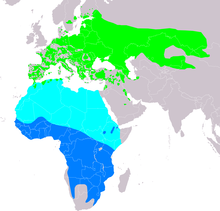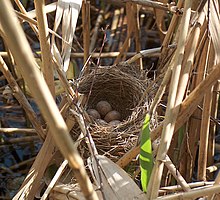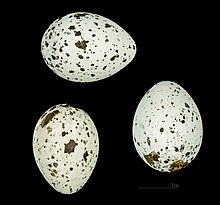Great Reed Warbler
| Great Reed Warbler | ||||||||||||
|---|---|---|---|---|---|---|---|---|---|---|---|---|

Great Reed Warbler ( Acrocephalus arundinaceus ) |
||||||||||||
| Systematics | ||||||||||||
|
||||||||||||
| Scientific name | ||||||||||||
| Acrocephalus arundinaceus | ||||||||||||
| ( Linnaeus , 1758) |
The reed warbler ( Acrocephalus arundinaceus ) is a songbird belonging to the genus of the reed warbler ( Acrocephalus ) and the reed warbler family (Acrocephalidae). There are two subspecies. In Central Europe the reed warbler is a regionally widespread, but only locally frequent breeding and summer bird.
description
The reed warbler is about 19 cm long and with a wing length of 9 cm is the largest of all Central European reed warbler species. The weight is about 25 to 36 grams. The top is brown, its underside yellowish white. The bird has a whitish throat, a strong beak and an indistinct white stripe across the eyes. Males and females have the same coloration. His singing sounds like "kaare kaare krieht krieht" to mark his territory.
distribution and habitat
The distribution area of the throttle warbler stretches from northwest Africa, Portugal and Spain to northeast China, the south of Sakhalin and the north of Japan. In Central Europe the reed warbler was originally widespread in the lowlands up to some low mountain ranges. Since the 1970s, there have been some very drastic falls in stocks. Since then it has shown large gaps in its distribution and is only a frequent breeding bird in north and south-east Central Europe.
The long-distance migrant is present in almost all of Europe from April to September. It has its winter quarters in tropical and southern Africa. Departure time and direction of movement are innate to him . The reed warbler lives in the dense reeds and bushes of lakes, ponds, moors and rivers. Ideal habitats are reed and reed cattail -Mischbestände that are three to six years old and having stalks of more than 6.5 millimeters in diameter. There should be between 34 and 62 stalks per square meter. The reed warbler can be found most often in reed belts at least five meters wide on larger still waters.
nutrition
The reed warbler climbs and hops skillfully in the reeds and feeds on spiders , mollusks , insects , their larvae , young amphibians and berries .
Reproduction
Sexual maturity occurs after a year. The main breeding season is May to July. The nest , made of grass and reed stalks, is woven into a bowl and is usually secured by three to four reed stalks above the water under the protection of reeds. The female lays four to six eggs . The eggs are 13 to 15 days long warmed. The young birds stay in the nest for 12 to 14 days. Cuckoo eggs are often found in reed warbler nests because they are of a similar color.
Duration
In Central Europe, the breeding area expanded significantly at the beginning of the 20th century. The beginning water reutrophication and an increase in the reed population contributed to this. The persistent water eutrophication as well as a sometimes considerable loss of habitat due to the drainage of wetlands led to a decline of the species from the 1950s onwards. This increased from the 1970s onwards. The Netherlands, Belgium, Germany, the Czech Republic and Slovakia, among others, saw very strong inventory declines. For example, the number of breeding pairs in the Netherlands fell from more than 10,000 breeding pairs in the 1950s to fewer than 300 breeding pairs in the 1990s. In Luxembourg and large parts of Belgium and Germany, some individual populations became extinct completely. Long-term largely stable populations can only be found in regions such as North Moravia and Poland, where there are large, undisturbed reed beds. Since the 1980s, stocks in Germany and the Netherlands have stabilized at a low level.
One reason for the decline in populations is often to be found in the fact that the reed warbler reacts more negatively than other reed warbler species to the silting of the reed bed. Eutrophication and the use of biocides have also led to a decrease in the number of larger insects during the breeding season. It is also sensitive to disturbances at the breeding site by water sports enthusiasts and other people seeking relaxation.
supporting documents
literature
- Hans-Günther Bauer, Einhard Bezzel and Wolfgang Fiedler (eds.): The compendium of birds in Central Europe: Everything about biology, endangerment and protection. Volume 2: Passeriformes - passerine birds. Aula-Verlag Wiebelsheim, Wiesbaden 2005, ISBN 3-89104-648-0 .
Web links
- Acrocephalus arundinaceus in the endangered Red List species the IUCN 2008. Posted by: BirdLife International, 2008. Accessed on December 22 of 2008.
- Videos, photos and sound recordings of Acrocephalus arundinaceus in the Internet Bird Collection
- FFH species and European bird species State Office for Nature, Environment and Consumer Protection North Rhine-Westphalia
- Age and gender characteristics (PDF; 1.9 MB) by Javier Blasco-Zumeta and Gerd-Michael Heinze (English)
- Springs of the throttle tube warbler
Single receipts
- ^ Bauer et al., S: 239
- ↑ Martin Flade: The breeding bird communities of Central and Northern Germany - Basics for the use of ornithological data in landscape planning . IHW-Verlag, Berlin 1994, ISBN 3-930167-00-X , p. 546
- ↑ Bauer et al., P. 239
- ↑ Bauer et al., P. 240



